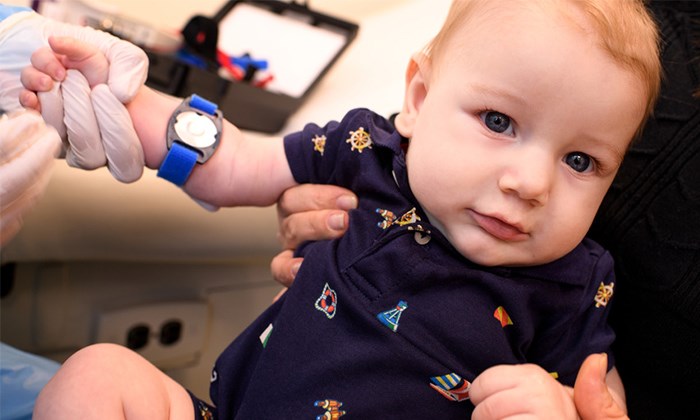Sweat TestIf you show symptoms of cystic fibrosis or your baby has a positive newborn screen for CF, a sweat test at a CF Foundation-accredited care center can help provide a CF diagnosis by measuring the concentration of salt in a person's sweat. This painless test is the most reliable way to diagnose CF.
|
Why does my child need a sweat test?
If your baby had a positive newborn screen (NBS) or you received a positive prenatal genetic test, it’s important to schedule a sweat test as soon as possible. At the latest, babies with a positive NBS or prenatal genetic test should have a sweat test performed by the age of 4 weeks to ensure that any health issues or changes can be found early and treated quickly. The sweat test can be done on an individual of any age. However, some infants may not make enough sweat to do the test. If an infant does not produce enough sweat the first time, the test should be repeated.
What is a sweat test?
The sweat test is considered the gold standard for diagnosing cystic fibrosis. Sweat tests should be done at a CF Foundation-accredited care center, where guidelines are used to help ensure accurate results. The sweat test is performed by a trained technician and the results are evaluated in an experienced and reliable laboratory.
If your baby had a positive newborn screen (NBS) or you received a positive prenatal genetic test, it’s important to schedule a sweat test as soon as possible. At the latest, babies with a positive NBS or prenatal genetic test should have a sweat test performed by the age of 4 weeks to ensure that any health issues or changes can be found early and treated quickly. The sweat test can be done on an individual of any age. However, some infants may not make enough sweat to do the test. If an infant does not produce enough sweat the first time, the test should be repeated.
What is a sweat test?
The sweat test is considered the gold standard for diagnosing cystic fibrosis. Sweat tests should be done at a CF Foundation-accredited care center, where guidelines are used to help ensure accurate results. The sweat test is performed by a trained technician and the results are evaluated in an experienced and reliable laboratory.
- What to expect: The sweat test measures the amount of chloride (a component of salt) in the sweat. There are no needles involved in this test. In the first part of the test, a colorless, odorless chemical (pilocarpine) and a little electrical stimulation is applied to a small area of the arm or leg to encourage the sweat glands to produce sweat. A person may feel tingling in the area, or a feeling of warmth. This part of the test lasts about five minutes. The sweat is then collected on a piece of filter paper or gauze or in a plastic coil. This step lasts for 30 minutes. The collected sweat is then sent to a hospital laboratory to measure how much chloride is in the sweat. The sweat test usually takes about an hour, but it may take longer.
- Preparing for a sweat test: There is no activity limit or special diet needed before the sweat test. However, you should not apply creams or lotions to the skin 24 hours before the test. You can continue all regular medications. These will have no effect on the test results. Babies should be fed their usual amount at their usual times.


